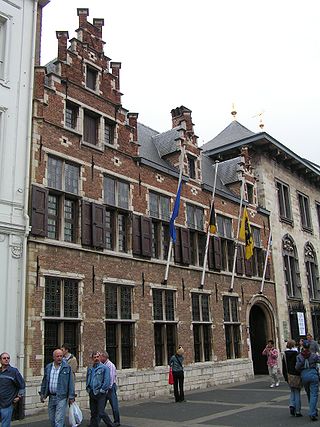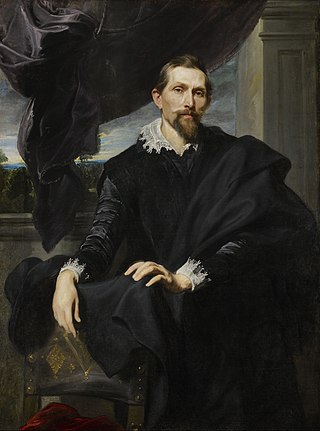
Frans Snyders or Frans Snijders was a Flemish painter of animals, hunting scenes, market scenes, and still lifes. He was one of the earliest specialist animaliers and he is credited with initiating a wide variety of new still-life and animal subjects in Antwerp. He was a regular collaborator with leading Antwerp painters such as Peter Paul Rubens, Anthony van Dyck, and Jacob Jordaens.

Isabella Brant was the first wife of the Flemish painter Peter Paul Rubens, who painted several portraits of her.

Sir Peter Paul Rubens was a Flemish artist and diplomat from the Duchy of Brabant in the Southern Netherlands. He is considered the most influential artist of the Flemish Baroque tradition. Rubens's highly charged compositions reference erudite aspects of classical and Christian history. His unique and immensely popular Baroque style emphasized movement, colour, and sensuality, which followed the immediate, dramatic artistic style promoted in the Counter-Reformation. Rubens was a painter producing altarpieces, portraits, landscapes, and history paintings of mythological and allegorical subjects. He was also a prolific designer of cartoons for the Flemish tapestry workshops and of frontispieces for the publishers in Antwerp.

Louis Béroud was a French painter of the late 19th, early 20th century. Some of his paintings are visible at the Musée Carnavalet and The Louvre in Paris. On 22 August 1911 Béroud came to The Louvre to sketch his painting Mona Lisa au Louvre but where the famous La Joconde, by Leonardo da Vinci, should have stood, he found four iron pegs. Béroud contacted the section head of the guards, who thought the painting was being photographed for marketing purposes. A few hours later, Béroud checked back with the section head of the museum, and it was confirmed that the Mona Lisa was not with the photographers. The Louvre was closed for an entire week to aid in investigation of the theft.

Het Steen, also known as the Rubens Castle (Rubenskasteel), is a castle in Elewijt, Flemish Brabant in Belgium. It was owned by the artist Peter Paul Rubens between 1635 and his death in 1640 and the castle features in some of his landscape paintings.

The Garden of Love is a painting by Rubens, produced in around 1633 and now in the Prado Museum in Madrid. The work was first listed in 1666, when it was hung in the Royal Palace of Madrid, in the Spanish king's bedroom. In early inventories, the painting was called The Garden Party.

HelenaFourment was the second wife of Baroque painter Peter Paul Rubens. She was the subject of a few portraits by Rubens, and also modeled for other religious and mythological paintings.

The Fur or The Pelt, also called The Little Fur, or Helena Fourment in a Fur Robe, is a c. 1636–1638 portrait by Peter Paul Rubens of his second wife Helena Fourment getting out of her bath and wrapping her voluptuous body in a fur. It is now in the Kunsthistorisches Museum in Vienna.

The Birth of the Milky Way, also sometimes known as The Origin of the Milky Way, is an oil-on-canvas painting by the Flemish artist Peter Paul Rubens, produced between 1636 and 1638 and featuring the Greco-Roman myth of the origin of the Milky Way. The painting depicts Hera (Juno), spilling her breast milk, the infant Heracles (Hercules) and Zeus (Jupiter) in the background, identifiable by his eagle and lightning bolts. Hera's face is modelled on Rubens' wife, Hélène Fourment. The carriage is pulled by peacocks, a bird which the ancient Greeks and Romans considered sacred to both themselves and to Hera/Juno, as a result of their ability to signal changes in weather through cries and hence their perceived connection to the gods. Due to the dark background of the night sky the figures gain a greater sense of volume.
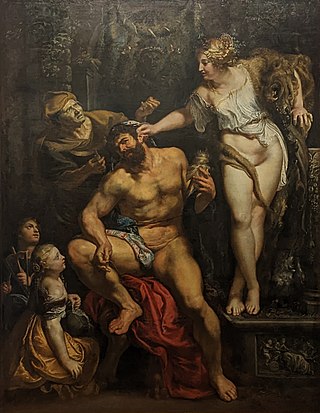
Hercules and Omphale is a circa 1602 painting by Peter Paul Rubens, now held in the Louvre Museum in Paris.

Helena Fourment with her son Frans is a c.1635 painting by Peter Paul Rubens, showing his second wife Helena Fourment holding their second son Frans. As of 2014, it is in the Alte Pinakothek in Munich.
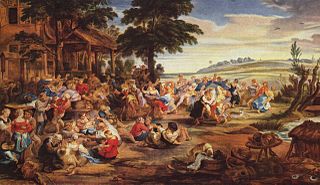
The Village Fête, La Kermesse or Noce de village. is a painting by Peter Paul Rubens, created in 1635–1638, now held in the Louvre Museum. It shows a 'kermesse' or village wedding.

Helena Fourment with Children is a c.1636 painting by Peter Paul Rubens, showing his second wife Helena Fourment with their son Frans in her arms and their daughter Clara Johanna standing to their left. It was acquired by Louis XVI of France in 1784 and is now in the Louvre Museum in Paris.

Portrait of Susanna Lunden or Le Chapeau de Paille is a painting by Peter Paul Rubens, in the National Gallery, London. It was probably painted around 1622–1625.

Crucifixion with the Virgin Mary, St John and St Mary Magdalene is a painting by Anthony van Dyck. He produced it in 1617-19 as the high altarpiece for the Jesuit church in Bergues, near Dunkirk, during his time as an assistant painter to Peter Paul Rubens - for a long time the painting was even attributed to Rubens. It was paid to Rubens in 1621 and seems to have been sold around 1746. It was bought by Louis XV of France in Antwerp in 1749 to be the high altarpiece of Saint-Louis de Versailles at the Palace of Versailles. It is now in the Louvre, in Paris.
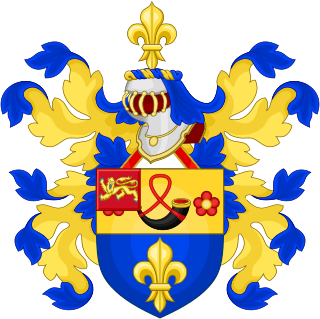
The Rubens family is a Flemish noble family that lived in Antwerp.

Albert Rubens (1614–1657), was the eldest son of Peter Paul Rubens and Isabella Brant. His research as a philologist and scholar of antiquity gained him the recognition of fellow scholars throughout Europe. He held an official position in the government of the Habsburg Netherlands as a secretary of the Privy Council of the Habsburg Netherlands.

Bacchus is a 1638-1640 oil painting of Bacchus by Peter Paul Rubens, now in the Hermitage Museum, in Saint Petersburg, for which it was purchased in 1772. It was originally on a panel support but was transferred to canvas in 1891 by A. Sidorov. An autograph copy of the work is now in the Uffizi in Florence.

Rubin's Europe was a temporary exhibition at the Louvre-Lens which took place in the temporary exhibitions gallery from May 22 to September 23, 2013, following the inaugural Renaissance exhibition. The exhibition brought together 170 works by Pierre Paul Rubens and his contemporaries, the majority of which were on loan from other museums.


